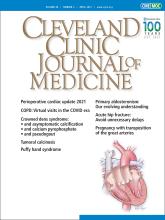Article Figures & Data
Tables
Preoperative condition or organ system Interventions and comments Fall Evaluate the cause of the fall, including cardiac and neurologic syncopal episodes. Correct complications from the fall such as rhabdomyolysis, dehydration, and acute renal failure. Diabetes Patients with severe hyperglycemia (glucose levels > 400 mg/dL), ketoacidosis, or on an insulin pump: treat with an insulin infusion preoperatively with a target glucose level of 140–180 mg/dL.
Patients with glucose levels > 180 mg/dL: the recommended total daily dose of insulin is 0.1–0.15 U/kg, given mainly as basal insulin, with correctional insulin coverage for glucose levels > 180 mg/dL before meals and at bedtime.Anemia, thrombocytopenia Evaluate anemia with a hemoglobin below 8 g/dL and thrombocytopenia with a platelet count < 100 × 109/L, and correct as needed. Anticoagulation before admission Evaluate an international normalized ratio (INR) > 1.5 and correct if needed. It is not necessary to have a normal INR or partial thromboplastin time before surgery. Assess continuation or reversal of anticoagulants. Respiratory Bronchospasm and hypoxemia require evaluation. For a patient with known asthma or chronic obstructive pulmonary disease, an exacerbation identified on preoperative evaluation may require acute bronchodilator therapy and consideration for surgical delay. Consider spinal anesthesia. Renal Discontinue angiotensin-converting enzyme inhibitors and angiotensin II receptor blockers preoperatively, and provide adequate hydration with isotonic fluid. Cardiovascular High-risk cardiac conditions should not disqualify surgery. Emphasis is on shared decision-making with the patient and family. Dose Comments First line: nonopioid analgesia Peripheral nerve block (femoral nerve block, fascia iliaca block) Ropivacaine 0.5%, 15–20 mL in primary block; if catheter placed, infusion may be run with ropivacaine 0.2% at 8–10 mL/hour Quadriceps weakness can be a limitation Acetaminophen 1,000 mg intravenously or orally every 6 hours For patient weighing < 50 kg, orally 650 mg every 6 hours Celecoxib 200 mg orally twice a day Use if glomerular filtration rate is > 60 mL/min Ibuprofen 400 mg by mouth every 6 hours Use if glomerular filtration rate is > 60 mL/min Opioids Tramadol 50 mg orally every 6 hours as needed for mild to moderate pain Use 25 mg if creatinine clearance rate is < 60 mL/min Oxycodone 2.5–5 mg orally every 4–6 hours as needed for severe pain Start with 2.5 mg if creatinine clearance rate is < 60 mL/min Hydromorphone 0.25 mg intravenously every 4–6 hours as needed Preferable to morphine, since morphine’s metabolites can accumulate in patients with impaired renal function
Respiratory depression, delirium, urinary retention, sedation, nausea and vomiting, and constipation are side effects of all opioids. Elderly patients may be particularly vulnerable to changes in mental status with opioidsMechanical valves Mechanical mitral valve Mechanical aortic valve in a patient with atrial fibrillation Mechanical tricuspid valve Mechanical aortic valve in a patient in sinus rhythm if it is anticipated that warfarin will not be promptly resumed after surgery Atrial fibrillation CHA2DS2–VASca score 7–9 without additional bleeding risks: major bleeding event or intracerebral hemorrhage < 3 months ago; international normalized ratio above the therapeutic range; prior bleeding event from previous bridging Any history of stroke or transient ischemic attack (ischemic or cardioembolic) Venous thromboembolism (VTE) VTE event within 3 months Severe thrombophilia with history of VTE or recurrent VTE (protein C or S deficiency, antithrombin deficiency, antiphospholipid antibodies, homozygous factor V Leiden, or multiple abnormalities); consider bridging for VTE in other thrombophilias (heterozygous factor V Leiden, heterozygous factor II mutation) History of VTE during discontinuation of anticoagulation ↵a CHA2DS2–VASc = 1 point each for congestive heart failure, hypertension, age 65–74, diabetes mellitus, vascular disease (coronary artery disease, peripheral arterial disease, aortic aneurysm), female sex; 2 points for age ≥ 75 and for prior stroke or transient ischemic attack (total possible points 9).
Based on information in references 38.
Drug Dosing and route of administration FDA-approved for VTE prophylaxis? Low-molecular-weight heparin Enoxaparin 40 mg subcutaneously daily Yes Fondaparinux 2.5 mg subcutaneously daily Yes Warfarin 3–5 mg by mouth daily for goal international normalized ratio 2–3 Yes Unfractionated heparin 5,000 U every 8 hours, every 12 hours for patients weighing < 50 kg
Use if creatinine clearance rate is < 230 mL/minYes Aspirin Unclear, dosing ranges from 81 mg orally twice a day for creatinine clearance rate < 30 mL/min, to 325 mg orally twice a day No Apixaban 2.5 mg orally twice a day No Dabigatran 150 mg orally daily No Rivaroxaban 10 mg orally daily No FDA = US Food and Drug Administration; VTE = venous thromboembolism
Based on information in reference 37.






